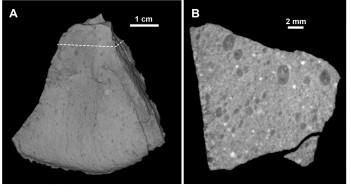A Meteorite Under the Microscope
October 22, 2015

Planetary Sciences
Researchers from the Jackson School of Geosciences have improved the understanding of planetary formation processes by analyzing the microstructures of a primitive meteorite on loan from the Smithsonian Institution.
The meteorite is a valuable scientific specimen because it’s a leftover from the earliest stages of planet formation in our solar system when dust orbiting the sun was beginning to coalesce, said Romy Hanna, a doctoral student who led the research.
“It’s original solar nebula material that never melted [into a planet],” said Hanna, who is also a NASA Earth and Space Science fellow.
Using X-ray computed tomography (CT) at The University of Texas at Austin High Resolution X-ray CT Facility in the Jackson School, Hanna found that the specimen’s chondrules, millimeter-sized spherical grains present in primitive meteorites, defined a foliation fabric. By analyzing their 3-D structure and characterizing their microstructures using electron microscopy techniques, Hanna determined that the chondrules likely underwent low energy, brittle deformation as a result of impacts on the parent asteroid body. This finding is in contrast to current knowledge that assumes chondrules are deformed by high energy, plastic deformation during impact.
The research was conducted in collaboration with Whitney Behr, assistant professor, and Richard Ketcham, interim chair of the Department of Geological Sciences and director of the X-ray CT facility.
Hanna presented the findings at the annual meeting of the Meteoritical Society in Morocco in September 2014 and received the Gordon A. McKay Award for the best student oral presentation at the meeting. A paper detailing the research is currently under review in Geochimica et Cosmochimica Acta, the journal of the Geochemical Society and the Meteoritical Society.
Back to the Newsletter